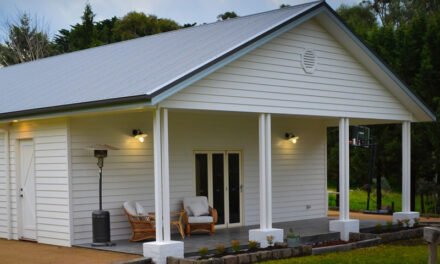A pint-sized but tough and manoeuvrable new forklift has improved speed and safety at Margaret River Mitre 10, and helped the business increase stock levels on site.
You can tell when someone likes a tool. It gets used a lot, and instead of being referred to by its brand or type, it often picks up a nickname. Lloyd Shepherdson is two minutes into talking about his business’s decision to buy a new forklift before he first refers to the machine as ‘the little tacker’, and it’s the perfect description.
Shepherdson is the co-owner of Margaret River Mitre 10. “We have about 25 people in any one shift, including seven or eight yardies,” he says. “The store is about 2000m2, made up of the main shop and sheds on the back fence. It’s a very tight site. We were a Home store for many years but we recently decided to go down the IHG group’s Sapphire remodelling path and get more stock in.”
Changing the store’s racking systems was an essential part of the remodelling. “The only way to fit extra racking in our sheds was to get a combi-type lift that could operate in the space of the machine cross-bundle instead of turning the bundle around,” Shepherdson says.
He had seen Combilift’s range online and in operation at trade events. “We were at a trade expo and I said ‘You’d better come and talk to us.’ We told them we were transitioning to the Sapphire program and had a lot of shop fittings coming in and out and a lot of stock to park temporarily in the shed while we re-laid the shop. We asked, ‘Can we hire one of these next week?’ They said yes, and then they came back to us and said, ‘Actually, we can sell you one within a week,’ so I said ‘Right, done!’”
The chosen model was the Combilift CB3000 with a 4.9m mast. With a small body profile and multi-directional wheels, it works as both a traditional counterbalance forklift and multi-directional truck and requires very little space to operate. “We did look at side trucks,” Shepherdson says, “but somewhere along the line, you had to have that full-length 6m turning place to turn the timber, whereas with this little tacker, you don’t.”
Shepherdson’s 15m-wide main sheds had racking down each wall, and what he describes as “10m or so of no-man’s land in the middle, because we had to fit the old lift in to get stuff off the top of the racks. Now we’ve got an extra double-sided tree rack down the middle and can work very comfortably in the aisle space of 3m.”
It’s changed the way the business manages stock. Previously, a lot of timber was kept at a remote site and shipped back and forth as needed. “We seemed to lose a bit of stock in the transitions,” says Shepherdson. “Both with knocks and with the remote site being less secure. I don’t know that we’ll ever achieve all our stockholdings in the one area, but at least now we can keep open bundles in the main store.”
Making the change
With two conventional forklifts already in use, it took a bit of time for the operators to adopt the new Combilift. “The first two weeks, I thought ‘oh no, they’re hardly using it, what’s gone wrong?’’’ Shepherdson says.
Once again the constraints of the site counted. The yard narrows sharply after its loading/unloading bay at the entry. “It’s pretty tight,” says Shepherdson. “We can fit a 3m-vehicle each side with a laneway in the middle. In the past, if we had two vehicles there and were trying to get bundles of timber through, they’d lift over the top of the vehicles, which our policy says we’re not to do. This little tacker can instead come along crab-walking with a 6m length of timber through the narrow space. It’s absolutely changed our safety culture.”
Other benefits also became quickly apparent: the new lift made some of the racking jobs easier and the fact the wheels sit neatly under the machine with no extending ‘feet’ lowers trip hazards for users.
“We now have one conventional forklift on this site, plus the Combilift CB3000,” Shepherdson says. “I shouldn’t say this, but the team love it – don’t print too much about that or Combilift will get a swollen head. It’s now the preferred lift: half the length of the other machine, but with the same sort of operational capacity.”
The one downside to that compact solidity came in the early days when the lift went through the water grates. “We had to increase the structural strengths of the grates for our drainage. It is a heavy little number because it’s got so much counterbalance weight on it in a short space.”
While they have had no problems to date, servicing and repairs are carried out by the Hyster agency, with a Hyster onsite service based in Busselton, just 50km away.
Although the lift was more expensive than others Shepherdson looked at, he sees broader benefits: “Not to belittle them, but if you got an accountant to go through every bit of your business before you spent a dollar, you’d never spend that dollar. It’s my gut feel that this little tacker is a necessity and will pay for itself in time. It’s already lifted our safety, and we can use it in much tighter spaces, so we can stock to a higher level and keep our customers happy.”
For more details on the CB3000, visit www.combilift.com.au
Image: Lloyd Shepherdson and the Combilift CB3000. Photo by Countrylux Photography.












